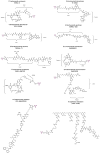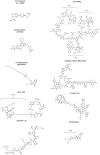Drug conjugates for the treatment of lung cancer: from drug discovery to clinical practice
- PMID: 38429828
- PMCID: PMC10908151
- DOI: 10.1186/s40164-024-00493-8
Drug conjugates for the treatment of lung cancer: from drug discovery to clinical practice
Abstract
A drug conjugate consists of a cytotoxic drug bound via a linker to a targeted ligand, allowing the targeted delivery of the drug to one or more tumor sites. This approach simultaneously reduces drug toxicity and increases efficacy, with a powerful combination of efficient killing and precise targeting. Antibody‒drug conjugates (ADCs) are the best-known type of drug conjugate, combining the specificity of antibodies with the cytotoxicity of chemotherapeutic drugs to reduce adverse reactions by preferentially targeting the payload to the tumor. The structure of ADCs has also provided inspiration for the development of additional drug conjugates. In recent years, drug conjugates such as ADCs, peptide‒drug conjugates (PDCs) and radionuclide drug conjugates (RDCs) have been approved by the Food and Drug Administration (FDA). The scope and application of drug conjugates have been expanding, including combination therapy and precise drug delivery, and a variety of new conjugation technology concepts have emerged. Additionally, new conjugation technology-based drugs have been developed in industry. In addition to chemotherapy, targeted therapy and immunotherapy, drug conjugate therapy has undergone continuous development and made significant progress in treating lung cancer in recent years, offering a promising strategy for the treatment of this disease. In this review, we discuss recent advances in the use of drug conjugates for lung cancer treatment, including structure-based drug design, mechanisms of action, clinical trials, and side effects. Furthermore, challenges, potential approaches and future prospects are presented.
Keywords: Clinical practice; Drug conjugates; Drug discovery; Lung cancer.
© 2024. The Author(s).
Conflict of interest statement
The authors declare that they have no competing interests.
Figures










References
Publication types
Grants and funding
- 81772477/National Natural Science Foundation of China
- 81201848/National Natural Science Foundation of China
- 82173684/National Natural Science Foundation of China
- 82204181/National Natural Science Foundation of China
- 82270104/National Natural Science Foundation of China
- 202303021221192/Fundamental Research Program of Shanxi Province
- zyyzdxk-2023083/National Administration of Traditional Chinese Medicine-Resource Chemistry of Chinese Medicinal Materials
- BE2023840/Key R&D Program of Jiangsu Province
- XPT82204181/Nanjing University of Chinese Medicine National Natural Science Foundation of China Counterpart Funding
- Z2021057/Jiangsu Provincial Health Commission
- HXQNJJ-2023-010/Young Doctors' Innovation and Development Program
LinkOut - more resources
Full Text Sources

